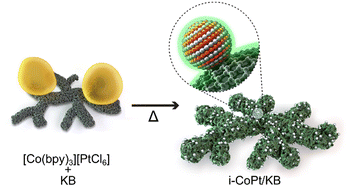Scalable production of an intermetallic Pt–Co electrocatalyst for high-power proton-exchange-membrane fuel cells†
Abstract
Power performance is the primary bottleneck to the industrial application of proton-exchange-membrane fuel cells, which hinges on catalytic activity, oxygen mass transfer, and proton conduction at the cathode catalyst layer. Tackling all these critical factors requires a holistic design of catalyst, embodied by an elaborate synthesis. Here we present a straightforward synthetic approach to address these practical issues. A bimetallic compound, formulated as [Co(2,2′-bipyridine)3][PtCl6], thermally decomposes and produces carbon-protected sub-5 nm-sized intermetallic Pt–Co nanoparticles, on which compressively-strained and rigid Pt-skin can be formed. In addition to the high intrinsic activity, we achieved the combined features of high electrochemical surface area, N-doping on the mesoporous carbon support, and highly stabilized Co that could promote oxygen mass transfer and proton conduction. In the single cell configuration, the catalyst achieved unprecedented rated power densities of 1.18 W cm−2 and 5.9 W mgPt−1 at 0.67 V (with a cathode loading of 0.1 mgPt cm−2), while experiencing voltage loss of only 29 mV (at 0.8 A cm−2) at the end of the test.



 Please wait while we load your content...
Please wait while we load your content...